Even more than its predecessor, the first Getty Pacific Standard Time initiative that ignited Los Angeles’ arterati six years ago, PST: LA/LA conjures a kind of Aleph-like quality in its ambition to encapsulate at its widest points the art of an entire continent, an archipelago of islands, and the appended LA metro region.
Geographic and other (cultural, historical, colonial, identity, conquest) proximities between those two LAs—Los Angeles and Latin America—affirm an inextricable link between the two.
The impressive range of exhibitions covers art- and object-making from as early as 1000 BCE—in the Getty’s own exhibition on luxury arts in the ancient Americas—to the present, with some works being made specifically for PST: LA/LA. Much of the work seems overwhelmingly political, which is to say that the artists who are represented in this explosion of exhibitions were in many cases responding to social, political and economic conditions with resistance to repressive power structures, military regimes and regressive social orders—or closer to home, resistance to social and economic inequalities, racial discrimination and prejudice.
Artillery’s editorial bent drew our eye to these conditions, yet many of the exhibitions that will be presented over the year engage with the formal innovations found in these works.
In considering what to recommend to our readers, Artillery was confronted by the reality that PST: LA/LA will begin a season of many firsts. Unlike the first PST initiative—in which there were many familiar names and works of art, and the effort focused on repositioning postwar LA art and spurring new scholarship—LA/LA presents hundreds of works of art that have never before been seen in Los Angeles or the United States.
The magnitude and scope of PST: LA/LA promises to be overwhelming. But even more than the last PST initiative, this is a once-in-a-lifetime series of exhibitions and events, so set aside the art fatigue: It promises to be worth every ounce of energy you can pour into it.
Artillery’s recommendations fall into two groups: nonprofits and PST-affiliated exhibitions at commercial galleries. The nonprofit spaces fall into categories based on each exhibition’s content or subjects, and one exhibition within each category is spotlighted. Commercial gallery recommendations are grouped geographically.
—Christopher Michno, Associate Editor
POLITICAL
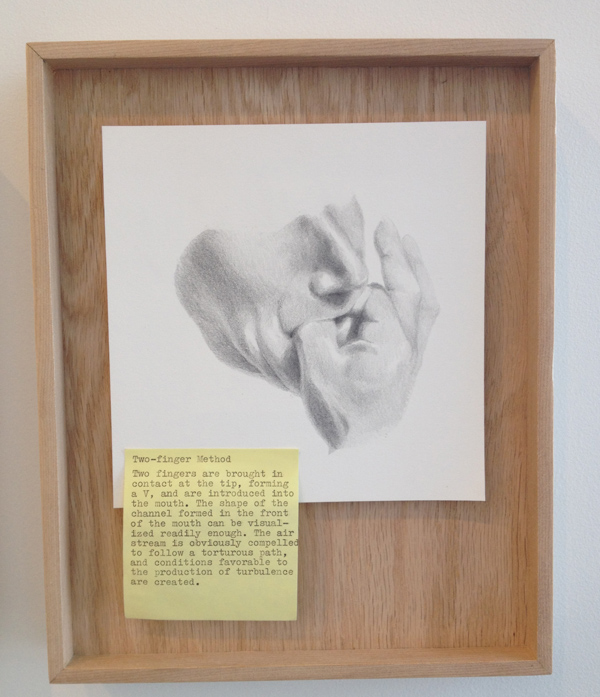
Gala Porras-Kim, Notes After G.M. Cowan 10, 2012, courtesy of the artist.
One of the smallest PST partners, 18th Street Arts Center laid groundwork for an exhibition at one of the largest. Much of the art in LACMA’s show featuring alternative artistic practices in Latin America and the U.S. was developed during residencies at the lesser-known Santa Monica institution. But 18th Street Arts Center’s work didn’t end there. Its own on-site companion show, A Universal History of Infamy: Virtues of Disparity, offers a chance to experience more intimately scaled works by artists ranging from local Gala Porras-Kim to São Paulo-based Runo Lagomarsino, a 2015 Venice Biennale participant. Organized by curators from LACMA and the Vincent Price Art Museum, works will address themes of likeness and deception, and investigate shortcomings of various writing and transcription systems and their contested relation to authenticity. What better way to exemplify PST’s wide-ranging collaborative spirit? —Annabel Osberg
A Universal History of Infamy: Virtues of Disparity, 10/9–12/15/17 at 18th Street Arts Center Main Gallery, 18thstreet.org
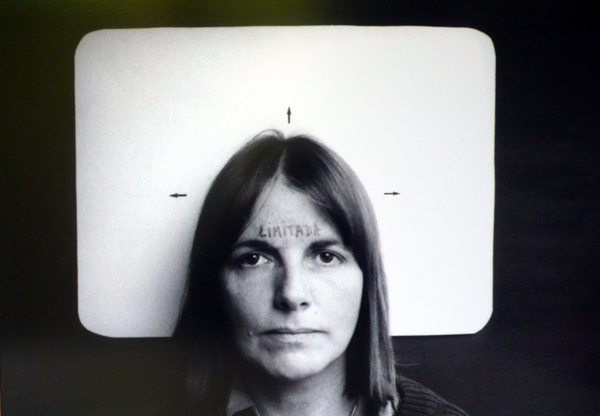
Marie Orensanz, Limitada, 1978, photo courtesy of the artist.
Recent initiatives have heightened the visibility of women overlooked by art history; but little consideration has been given to Latina artists and their unique struggles. Amending this omission, the Hammer Museum’s Radical Women: Latin American Art, 1960–1985 will showcase art by daring women who resisted the status quo. Seeking freedom amid social repression, machismo, and political turbulence, these artists explored the politicization of the female body. Corporeal representations became their points of departure for denouncing violence and challenging the artistic canon. From Zilia Sánchez’ geometric abstractions to Ana Mendieta’s body art, their iconographies are simultaneously personal, political, and poetic. Exhibiting work in a wide range of media by over 100 artists from 15 countries, this scholarly and engaging show promises to constitute the first genealogy of feminist and radical women’s art practices in Latin America. ¡Arriba las mujeres! —A.O.
Radical Women: Latin American Art, 1960–1985, 9/15–12/31/17, Hammer Museum, hammer.ucla.edu
————————————————————————————————–
Armory Center for the Arts
Below the Underground: Renegade Art and Action in 1990s Mexico
10/15/17–1/21/18
Artists engage with politics through alternative, clandestine art practices emergent in 1990s Mexico in response to increasing violence, currency devaluation, industrial pollution and political corruption.
Craft & Folk Art Museum
The US-Mexico Border: Place, Imagination, and Possibility
9/10/17–1/7/18
The actuality of the border as a real place is held in tension with its intangible, conceptual power to drive the imagination and as a site for possibilities in the works of contemporary artists and designers. See feature on Ana Serrano on page 40.
Millard Sheets Art Center
Judithe Hernández and Patssi Valdez: One Path Two Journeys
9/1/17–1/28/18
Within a culture, a socio-political movement and a profession dominated by men, artists Judithe Hernández and Patssi Valdez each created bodies of works that profoundly influenced the aesthetic voices of Latinas in the latter half of the 20th century. See page 46.
UCLA Chicano Studies Research Center
Home—So Different, So Appealing: Art from the Americas since 1957
6/11–10/15/17
Features Latin American and U.S. Latino artists from the late 1950s to the present who have used the deceptively simple idea of “home” as a lens for exploring changes in the Americas.
DIASPORA & THE POST-COLONIAL EXPERIENCE
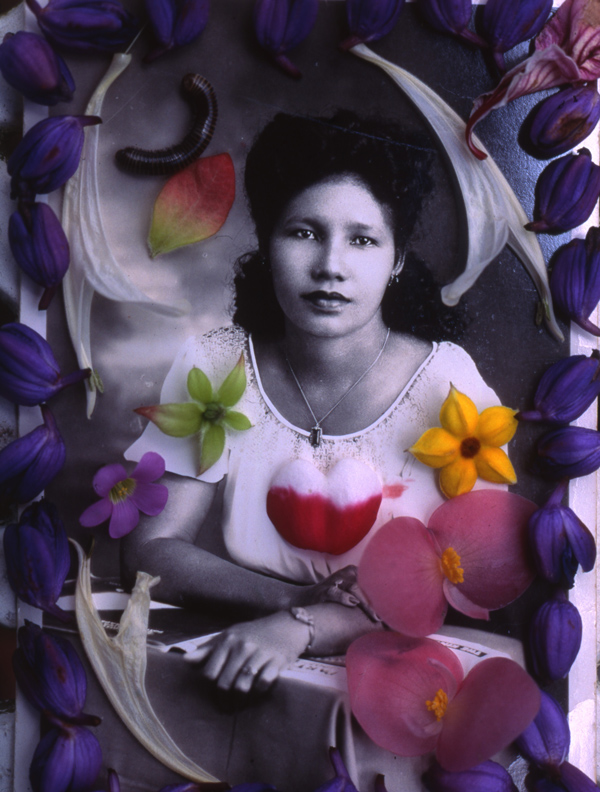
Albert Chong, Aunt Winnie, 1995, © Albert Chong.
People of Asian descent usually aren’t at the forefront of discussions regarding Latin America; that makes Circles and Circuits: Contemporary Chinese Caribbean Art all the more intriguing. The 1800s saw significant Chinese migrations to the West Indies; this vibrant two-part exhibition highlights their descendents’ artistic contributions. Delineating Sino-Caribbean art history beginning in the 1930s, the California African American Museum will feature artists little known outside their countries of Cuba, Panama, Trinidad and Tobago, and Jamaica. It’s hard to believe that Sybil Atteck, a Trinidadian expressionist who studied with Max Beckmann, or Manuel Chong-Neto, a Panamanian painter whose figures evoke Art Deco and Fernando Botero, aren’t more famous. Their work will provide context for that of Albert Chong, María Magdalena Campos-Pons, and other contemporary Caribbeans at the Chinese American Museum. Popular culture, personal and post-colonial history and the body will figure prominently in novel multicultural works. —A.O.
Circles and Circuits: Contemporary Chinese Caribbean Art, 9/15/17–2/25/18 at California African American Museum, caamuseum.org; 9/15/17–3/11/18 at Chinese American Museum, camla.org
—————————————————————————————————-
Fowler Museum at UCLA
Axé Bahia: The Power of Art in an Afro-Brazilian Metropolis
9/24/17–2/11/18
Explores the complexities of race and cultural affiliation in Brazil and the realities of Afro-Brazilian identity in Bahia.
Museum of Latin American Art
Relational Undercurrents: Contemporary Art of the Caribbean Archipelago
9/16/17–1/28/18
Examines race, colonialism, and the environment through the experience of the island nations of the Caribbean and their diasporas, and challenges conventional geographic and conceptual boundaries of Latin America. See interview on page 79.
Museum of Contemporary Art Santa Barbara (MCASB)
Guatemala from 33,000 Kilometers: Contemporary Art from 1960–Present
9/17–12/17/17
Two-part (MCASB & Westmont College) survey of the unexplored history of contemporary art production from the beginnings of the Guatemalan civil war to the present day.
Museum of Photographic Arts (MOPA), SAN DIEGO
Displacement: Mexican Photography, 2000–2012
9/30/17–2/11/18
Inheriting the social reforms of the 1990s, artists used a range of practices of manipulated photographs, installations and videos to explore the fracturing of personal and cultural identities in the new Mexico.
GENDER & LGBTQ
ONE National Gay & Lesbian Archives at USC
Axis Mundo: Queer Networks in Chicano L.A.
9/9–12/31/17
Maps the intersections and collaborations among a network of queer Chicano artists from the late 1960s to the early 1990s.
FILM & VIDEO
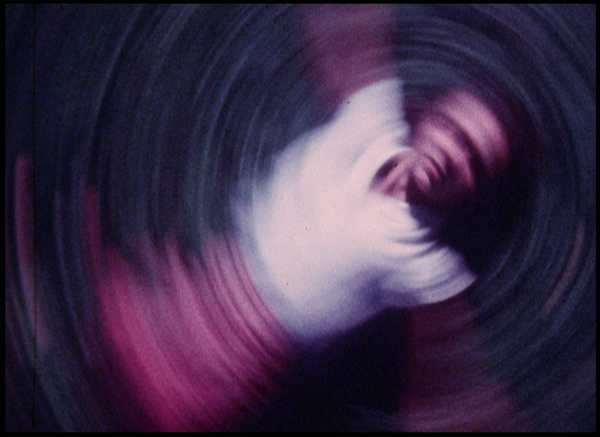
Claudio Caldini, Argentina, Un enano en el Jardin, 1981,© Claudio Caldini 1981.
There’s nothing better than going to the movies and actually learning something. Fortunately, cinephiles have more to look forward to this fall than watching Star Wars. Comprising 16 screenings hosted in various Southern California venues, most including local and national premieres, Ism, Ism, Ism: Experimental Cinema in Latin America will offer opportunities to view innovative 20th-century films largely unknown in the United States. Rare cinematic masterworks, cutting-edge experiments, and recorded performances will be presented with materials elucidating the history, aesthetics and circulation of independent and experimental Latin American and Latino filmmaking. Film buffs will not want to miss the chance to see works by Brazilian artist Hélio Oiticica, Mexican photographer Manuel Álvarez Bravo, and queer Ecuadorian filmmaker Eduardo Solá Franco alongside social documentaries by El Centro Experimental de la Universidad de Chile and punk films of Mexico’s Superocheros. —A.O.
Ism, Ism, Ism: Experimental Cinema in Latin America, various SoCal venues, Sept. to Jan. 2018; LA FILM FORUM, lafilmforum.org/ismo-ismo-ismo/ and ismismism.org
—————————————————————————————————
LAXART
Video Art in Latin America
9/16–12/16/17
The first major survey of Latin American video art in the U.S. features work rarely, if ever, seen here, beginning with the earliest experiments in South America, where video was an important means to express dissent, to the present moment.
MONOGRAPHIC SHOWS
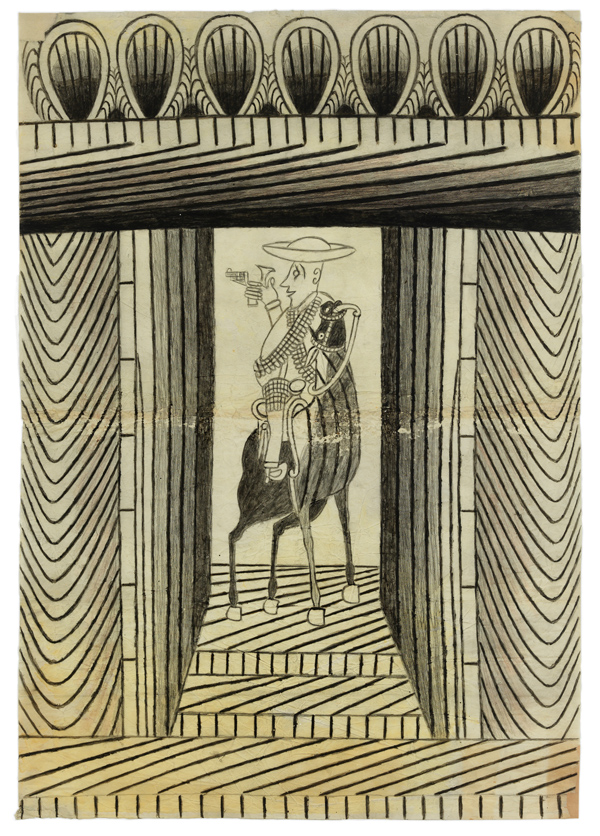
Martín Ramírez, Untitled ( Horse and Rider with Frieze), n.d., ©The Estate of Martín Ramírez Ricco/Maresca Gallery, NY, photo by Tom Van Eynde.
Formerly the Santa Monica Museum of Art, ICA LA will inaugurate its 12,700-square-foot space with the Southern California solo debut of Martín Ramírez (1895–1963), acclaimed as a self-taught master of drawing. In 1925, Ramírez immigrated from Jalisco to California where he worked on railroads for six years before becoming an unemployed drifter. Incarcerated for unknown reasons, he was eventually institutionalized for manic depression and schizophrenia—diagnoses that have recently been called into question. This timely show will offer a fresh perspective on his visionary iconography, trace his connections to mainstream modern art, and explore the significance of his cultural identity. Additionally, a 17-foot scroll comprising a glossary of his motifs and a visual narrative of his journey from Mexico to California will be displayed for the first time. Given contemporary issues of immigration, confinement, and mental illness, perhaps Ramírez’ art is more relevant than ever. —A.O.
Martín Ramírez: His Life in Pictures, Another Interpretation, 9/9–12/31/2017 at ICA LA, theicala.org
———————————————————————————————–
MOCA
Anna Maria Maiolino
8/4–11/27/17
The aftermath of the WWII and the military dictatorship in Brazil profoundly affected the work of this influential Brazilian artist, seen here in her first major U.S. survey.
LACMA
Playing with Fire: Paintings by Carlos Almaraz
8/6–12/3/17
Almaraz’ large-scale paintings feature prominently in the first major retrospective of this influential Los Angeles artist and activist who helped catalyze the Chicano Art movement in the 1970s.
USC Fisher
James hd Brown: Life and Work in Mexico
9/19–12/2/17
This exhibition will highlight Brown’s unique artist press, featuring approximately 20 books and related ephemera, including a new artist book especially for PST: LA/LA.
Santa Barbara Museum of Art
Valeska Soares: Any Moment Now
9/17–12/31/17
New York-based Brazilian artist’s mid-career survey features 25 years of installations, sculptures, photography, video, and performances that integrate notions of memory, time and the senses.
PHOTOGRAPHY

Tatiana Parcero, Cartografia Interior #43, 1996, Scripps College, photo by jdc Fine Art.
Three generations of Mexican women photographers, their careers spanning 100 years, convene in Revolution and Ritual: The Photographs of Sara Castrejón, Graciela Iturbide, and Tatiana Parcero at the Ruth Chandler Williamson Gallery at Scripps College. Addressing conflict, transformation, and culture, their haunting and revelatory portraits encompass genres from documentation to self-expression. Sara Castrejón was one of the few women photographers who documented the Mexican revolution; her photos will be presented here in the U.S. for the first time. The pictures of Graciela Iturbide, who studied with Manuel Álvarez Bravo, offer glimpses into the everyday life of indigenous cultures like the Zapotec, Mixtec and Seri. In Tatiana Parcero’s dreamlike montages found images of codices, cosmological diagrams and colonial maps overlay her own body. The surprising junction of this photographic trio seems an ideal lens for contemplation. —A.O.
Revolution and Ritual: The Photographs of Sara Castrejón, Graciela Iturbide, and Tatiana Parcero, 8/26/17–1/7/18 at Ruth Chandler Williamson Gallery at Scripps College, rcwg.scrippscollege.edu
———————————————————————————————–
J. Paul Getty Museum
Photography in Argentina, 1850–2010: Contradiction and Continuity
9/16/17–1/28/18
Featuring more than 60 artists, spanning 150 years, this exhibition emphasizes crucial historical moments and aesthetic movements in Argentina in which photography played a critical role.
Los Angeles Municipal Art Gallery
Learning from Latin America: Art, Architecture, and Visions of Modernism
9/10/17–1/27/18
30 contemporary artists respond critically to the history of modernism and modernist architecture in Latin America, exploring its effects, contradictions and contested legacies.
PERFORMANCE
REDCAT
Pacific Standard Time: Live Arts LA/LA Festival
1/11–1/21/18
A ten-day international festival of Latin American and Latino performance art that reflects the most recent developments in contemporary performance and time-based art.
LACE
Juan Downey: Radiant Nature
9/9–12/8/17 and 9/13–12/3/17
A two-part exhibition on the early performance-based artworks of Juan Downey comprising a progressive trans-disciplinary investigation of technology, energy, the environment and politics.
TRANSHISTORICAL
University of California, Riverside ARTSblock
Mundos Alternos: Art and Science Fiction in the Americas
9/16/17–2/4/18
Contemporary artists from across the Americas employ the imagery of science fiction to suggest diverse modes of existence, tapping into the genre’s capacity to imagine new realities.
Mingei International Museum
Art of the Americas: Mesoamerican, Pre-Columbian Art from Mingei’s Permanent Collection
9/16/2017–2/18/2018
A comprehensive presentation of the musuem’s significant holdings of objects used by people from the ancient cultures of Mexico, Central America, and South America. A rare collection of Mayan textile fragments will also be presented.
Self Help Graphics & Art
9/17/17–1/20/18
Día de los Muertos, A Cultural Legacy: Past, Present, and Future
Traces the evolution of Día de los Muertos in Los Angeles and beyond through an exhibition and publication documenting its four-decade history of art, ritual and celebration.
PST opens September through October. For more listings, visit pacificstandardtime.org

